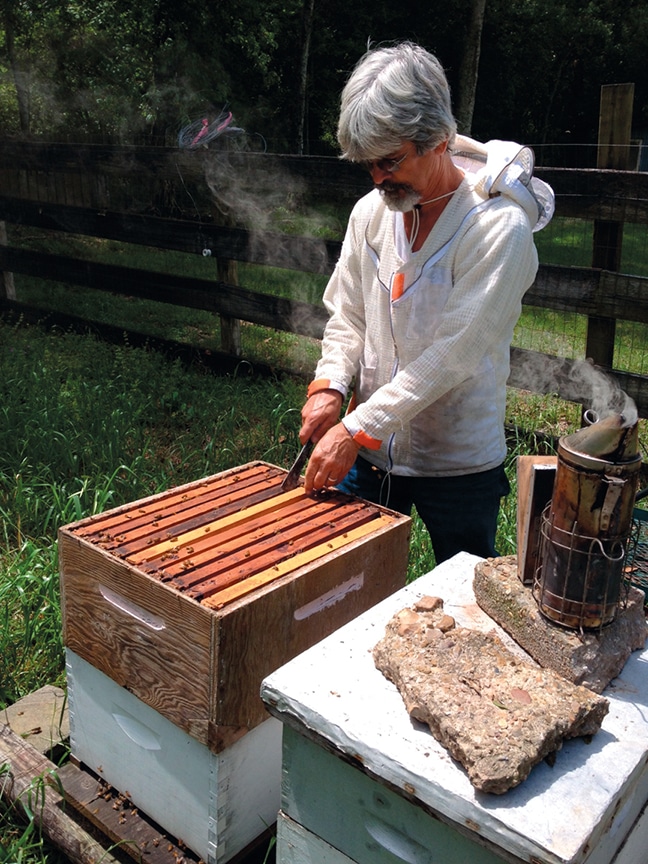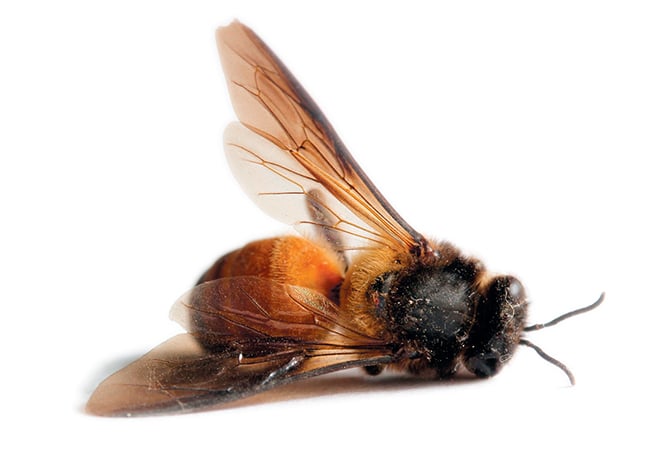Here’s Why — And Why It Matters A Great Deal.
By Karla Wall
If you’re bemoaning the fact that, as the weather warms, those pesky, buzzing, stinging little pests called honeybees are once again making a nuisance of themselves during your gardening sessions, barbecues and pool parties, it might be time to take action.
And I’m not talking about grabbing the nearest can of Raid.
Instead, you might want to change your attitude.
These busy little insects might not seem like much, but they carry a rather large portion of responsibility for our well-being on those little striped backs.
In fact, Albert Einstein is famously quoted as saying, “If all the honeybees disappear, mankind will disappear within three years.”
Hyperbole? Exaggeration? Not really.
No Bees, No Food
Swarms of honeybees, of course, gather nectar and pollen from whatever plants are in their general vicinity, in order to produce food for the colony. In the process, they carry the pollen gathered on their bodies from one plant to another, cross-pollinating the plants they visit, and enabling those plants to produce fruit (numerous species of plants can produce fruit only when cross-pollinated).
That, shall we say, beneficial side effect of the bees’ search for food has long been harnessed by farmers and orchard owners in order to produce most of the fruits and grains we eat — including superfoods such as blueberries, apples, broccoli and squash.
In fact, author Rowan Jacobson wrote in a 2009 issue of Eating Well that “if it lowers cholesterol, improves eyesight or turbocharges the immune system, it was probably fertilized by a bee.”
Commercial beekeepers often make a living hiring out the services of their bees. Farmers contract to have the bees placed on their property, and the beekeeper places his hives in the best position to allow them to pollinate the farmer’s crop. It’s estimated that more than a million hives (of about two million hives kept in the U.S.) are transported from crop to crop each year. Since bees rarely travel much further than a mile or two to feed, concentrating on what’s immediately on hand, the power of bees can be focused on a small area, and a single crop.
The list of food crops pollinated by bees incudes most of our staples: apples, apricots, cranberries, nectarines, peaches, pears, cucumbers, cantaloupes, almonds, persimmons, plums (prunes), pumpkins, raspberries, watermelon, okra, pepper, lima beans, soybeans, grapes, eggplants, grapefruit, carrots, onions, avocados, peas, field beans, corn, snap beans, and the list goes on and on.
To put it in perspective: It’s estimated that, of the 100 crops that supply 90 percent of the global food supply, 71 are pollinated by bees — that translates to about $16 billion annually. In all, the bees contribute about $29 billion annually to the income of U.S. farmers.
But these oh-so-important “farm workers” are dying out, and at an alarming rate.
Dwindling Population
The website keepingbees.com reported recently that the honeybee population has decreased by 50 percent in the last 50 years. But it’s in the last few years that the real decline has been noticed. In fact, CNN reported that, since 2007, an average of 30 percent of all colonies have died every winter, about double what U.S. beekeepers consider economically sustainable. In the winter of ‘08, the report states, 36 percent of the estimated 2.4 million hives in the U.S. were lost, 13 percent more than the previous year, and over 40 percent more than in 2006. In 2010 and 2011, 30 percent of bee colonies were lost.
Bee populations (not only cultivated honeybees, but wild honeybees, bumblebees and other beneficial pollinators) face several dangers, ranging from pesticides to viruses to parasites. Beekeepers are finding it increasingly difficult to keep bees alive.

The Eating Well article relays the story of a beekeeper who lost 24 hives that he had placed on a California almond orchard, under contract with the orchard owner. It was completely unexpected. The keeper went out to check on the hives, and found the boxes empty. The loss was chalked up to Colony Collapse Disorder.
Colony Collapse Disorder was first reported in 2006, but it seems to be a catch-all phrase for the loss of an entire hive or colony — one minute the bees are there and healthy, the next they’re either gone or most of them are dead. And there are several factors that might lead to this type of loss.
Insecticides
Jennings beekeeper Warren Hoag, who’s kept bees for 15 years and serves as president of the Bayou Beekeepers Club in Jennings, says that for local beekeepers, who don’t necessarily move their bees constantly, CCD isn’t a huge problem. Pesticides are.
“Bees are insects; insecticides and pesticides kill bees,” says Hoag. “If your bees are on commercial farms where pesticides are sprayed, they will be exposed to them. Mosquito Control planes spray pesticides and insecticides. Many gardeners and farmers use broad-spectrum insecticides and pesticides that not only kill bees, but also other pollinators and many other beneficial insects, in an attempt to wipe out one type of bug that is bothering them.”
But systemic insecticides, according to keeping-honey-bees.com, can cause disorientation, feeding problems and “communication disorders” among the hive, all symptoms associated with CCD. Even if bees aren’t sprayed directly with insecticide, they can absorb or ingest it from the plants and pollens they’re exposed to, and their immune systems suffer as a result.
Parasites
Hoag says mites and other parasites are a problem for local bees. One of those parasites is the varroa mite, which can enter the bees’ bodies through a wound. The mite not only attacks the bee’s body, it carries viruses which infect the bee, and ultimately the entire colony. One of those viruses, Israel Acute Paralysis Virus, causes deformation of wings and abdomens in bees.

Other parasites Hoag says local bees are susceptible to include hive beetles and wax moths.
VIRUSES
The Tobacco Ringspot Virus, which attacks plants, was also recently found in honeybees, according to Science Daily. The study, conducted by the U.S. Dept. of Agriculture’s Agricultural Research Service, was the first to report the disease, and also provided the first evidence that, not only do bees transmit plant viruses from one plant to another, but they can also absorb the virus themselves, and become infected.
Other viruses bees are vulnerable to include Chronic Paralysis Virus, Kashmir Bee Virus, Deformed Wing Bee Virus, Black Queen Cell Virus and Sacbrood Virus.
It’s likely, the Science Daily report says, that a “cocktail,” or mixture, of these viruses are responsible for most CCD cases.
What You Can Do
The first and foremost line of defense against the dangers facing cultivated bee populations is to maintain healthy hives, says Hoag, so it’s important for beekeepers to not only carefully monitor and maintain the health of their winged charges, but also to make sure the bees’ environment and hives are kept clean.
“The best thing to do is keep strong, healthy hives,” he says. “And pay attention to where you put your bees, and what they forage on; it can literally be a matter of life and death to them.”
Since it’s not only cultivated bees that suffer from the above maladies, and since wild bee populations are also important to the health of the environment and our food supply, it’s important for the average homeowner to keep the health of bees and other pollinators in mind.
Plant with bees and other pollinators in mind. Maintain nectar producing plants (preferably native species) that attract and sustain bees, wasps, hummingbirds and other pollinators.

Look into natural insect control (perhaps introducing some of those beneficial insects such as ladybugs into your garden or yard to control unwanted pests).
Re-think the use of herbicides, as well. Consider making the extra effort to edge the sidewalk and trim the fenceline by hand, rather than spraying those areas with a herbicide.
Get informed and involved. Go to a beekeepers’ club meeting to learn more about bees, and about beekeeping, if you think you’d like to keep a hive or two on your property. Bayou Beekeepers Club meets monthly, and Hoag will begin teaching a beekeeping course. For more information on the club and the course, call Hoag at 337-824-0937. The SWLA Beekeepers Assoc. also meets monthly, in DeRidder. For more information, call 337-463-7006, or email KHawkins@ agcenter.lsu.edu.
Call a beekeeper to rid your home of unwanted bees. One of the most important things you can do to help out the bee population is to call an experienced beekeeper if you find that a swarm has taken up residence in your home, outdoor buildings, old vehicle on the property, etc., rather than buying up Wal-Mart’s supply of Raid to take care of the problem. There are several local keepers who can help rid you of the bees, while keeping them alive and healthy.
Here’s a list:
• Kane Mitchell: 337-496-9770
• Sid Guidroz, Jr.: 318-201 8096.
• Keith Townley: 337-527- 8438
Or, contact Hawkins at the LSU Ag Center at the above number and email address for the name of someone who can help.


















Comments are closed.